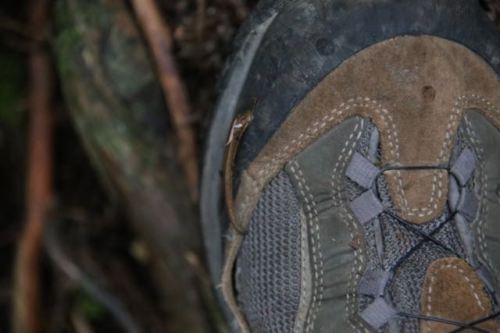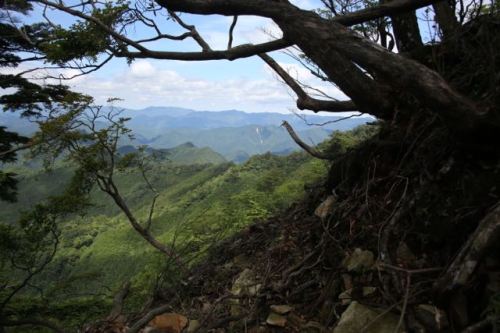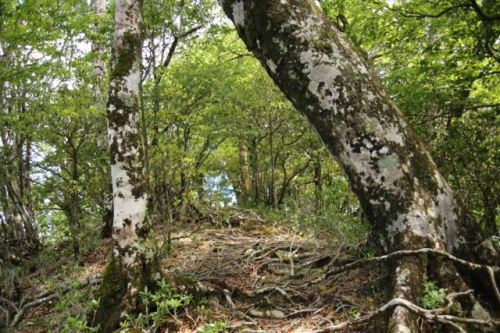Maybe it was the report from NHK about the Ootō mountains that concerned me. With an annual rainfall average of 4000 mm, the mountain range tucked away in central Wakayama Prefecture is only slightly drier than Odaigahara, one of Kansai’s wettest places. The frequent rains and high humidity provide the perfect habitat for the yamahiru, or Japanese mountain leech. Trip reports from other bloggers recommended that hikers best avoid the Ootō mountains during the warm summer months. Perhaps Ayako and I were tempting fate with our plan for an early June ascent, but with only 4 mountains left on the list, it was now or never.

Ayako picked me up at Gobo station just before 10am as the last of the morning mists were starting to burn off for the day. The asphalt still lay heavy from the overnight rains as she pointed the car east, away from the coastal sea spray and deep into the heart of Wakayama Prefecture. Most guidebooks recommend an ascent from the east through a narrow gorge that follows the headwaters of the Koza river, but this access route required an additional two hours of driving, time that we simply could not afford to lose. My map showed an alternative approach up the northern face of the massif, a straight shot along a winding forest road just off of route 371. It was this same junction that we passed back in March on our maiden ascent of Hansamine. It took nearly two hours of navigating an incredibly twisted and thin slice of concrete to reach an unmarked gate that led to the start of the hike.

We stepped out into the refreshingly brisk air, sorting through kit between bites of rice balls and energy bars. We’d need those calories for the 700-meter vertical elevation gain spread out over just a couple of kilometers. The clouds still hung tightly to the ridge somewhere high above us, but a rise in the pressure on my barometer indicated a favorable window for the afternoon climb. The first part of the approach was along an abandoned forest road following a swift-moving mountain stream. The path terminated at a pair of cryptomeria trees estimated to be over half a century in age. Between the gap in the trees a small shrine has been erected, along with a signpost indicating that the towering cedar has been selected as one of the ‘100 Forest Giants of Japan‘.

The path started just opposite this old growth relic. I took the lead, tramping through the soft cedar needles still damp from the incessant rains of late. With my trekking pole gripped tightly in my left hand, I reached the first switchback, no more than 15 meters away from the forest road. In that short space of time, barely 30 seconds by my watch, a mountain leech had jumared up my trekking pole and latched onto my left index finger. It was tiny, less than the length of a toothpick, but the grip it had on my cuticle required the force of both the thumb and index finger of my right hand to remove the blood-sucking creature. Fortunately it had only latched on to the nail and had not started extracting blood.

Ayako jumped back in surprise as I flicked the leech back to the forest floor. It was early in the season, and the segmented worms has just awoken from their winter slumber, eager for a taste of fresh blood. “If we run into any more then we’ll turn around”, I proclaimed, setting her mind at ease ever so slightly. Constant vigilance is required to spot the mountain leeches. They can not only climb up your trekking poles and trousers but they can also abseil from the foliage above, landing on your neck for a vampire-esque attack. Such sustained scanning is exhausting, but I was determined not to let out unwanted guests get the upper hand.

Tightening the dials on my boa laces, I tucked my hiking pants snug against my boots, creating a makeshift gaiter that would hopefully keep the leeches from getting inside my shoes. The system seemed to work, for a few hundred meters higher up the valley, I caught another leech in mid-ascent of my thigh and easily plucked it off my beige hiking pants. I decided not to disclose my discovery to Ayako, hoping that we’d be out of the leech zone once we breached the ridge. It was a steady climb of about an hour before we did reach the ridge. Just before topping out a leech had dropped from a branch above and landed on my arm, I made quick work of it before it could gain purchase.

We took our first break when the contours flattened out, near an unnamed peak that the map simply calls ‘849’ in reference to its altitude. The crux of the climb was over, or so we thought. Even though we only had 300 meters of vertical elevation, the first thing the trail did was to drop 100 vertical meters to a saddle, where we greeted the northern face of the mountain head on. It was an improvised scramble up a root-infested spur for the better part of an hour. The only saving grace in the slog were the vistas opening up directly in back – the low-lying cloud had finally risen.

In spite of the pitch, the route was clearly marked with red tape affixed to the trees, and it was simply a matter of using the exposed roots as a natural staircase to inch our way towards the summit plateau. At the top of the rise we reached an unmarked junction, where our alternative path merged with the main path on the true ridge of the Ootō range. After dropping to a saddle, we faced one final, steep climb through a network of net and wire fences erected to keep the deer at bay.

Such fencework seems overkill, but the western and southern faces of the summit plateau have been destroyed by the deer, who have killed the trees by stripping them of bark. In addition, they’ve eaten all the seedlings, which prevents any new trees from growing in these grassy areas. Unheeded, these open areas allow more sunlight, wind, and heat to penetrate the summit plateau, which is causing stress on the beech, fir, and hemlock trees that still keep a watchful eye on the forest floor. Such post-war cedar plantations failed to penetrate the upper reaches of the massif, thanks in no small part to the Taisho-era government, who back in 1924 designated the Ootō mountains as a protected forest.

The destruction of the trees on the summit did have one positive effect, however, as visitors can now get a bird’s eye view of the entire Ootō range. Peering over the fence, I could follow the contours of the ridge all the way over to Mt. Hōshi, just one of three remaining mountains on the Kansai 100 list. If I had more time I could simply work my way over there, but with the leech season in full swing, it seemed better to wait.

On the return descent back to the car, the afternoon heat had dried the trail, sending the leeches back into the burrows on the bottom of the forest floor, so the blood-suckers were nowhere in sight. Peak #97 of the 100 was now in the books, and with just a trio of peaks standing in my way, I now had a clear shot of finishing before the end of the year.






